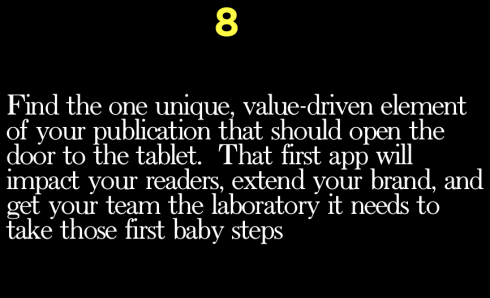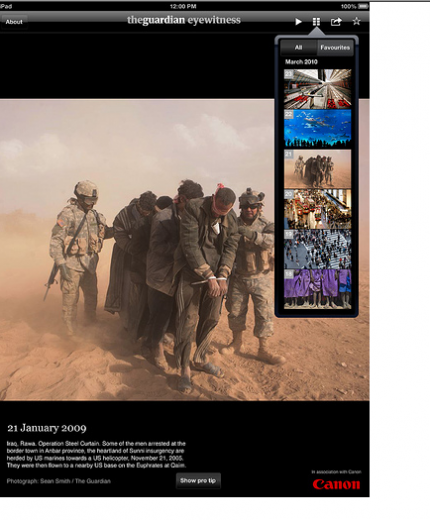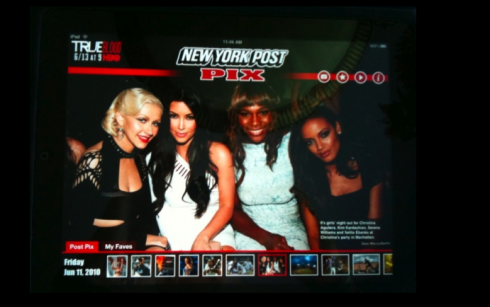Update #2, Wednesday, June 23, 12:46 EST
TAKEAWAY: It is a question frequently asked: how can we take our newspaper or magazine into the tablet when we are not fully prepared to do so? Try your best feature first, before the rest comes.

At the end of The Power of the Tablet conference, I offered a list of 10 items to take home. This was #8, and a very important one.
What’s your strongest content?
It happened during lunch yesterday again: two editors from a newspaper in Ecuador were visiting El Tiempo here in Bogota, and the discussion turned almost 80% to tablets and what they will bring to media houses, and, of course, how can a newspaper or magazine enter into the world of tablets.
The answer is simple: put your best foot forward and into the tablet screen.
As we heard repeatedly at the Poynter conference on The Power of the Tablet
, the idea is to analyze your publication, find those things that people value the most in it (or might be willing to pay for), then devote your first app to that.
Whatever you do, a tablet edition is not your chance to pour the entire contents of your newspaper or magazine into it.
The Guardian

Perhaps one of the most popular newspaper apps, and one of my favorites, is London’s The Guardian’s Eyewitness app, which is entirely a photo gallery, based on the very successful similar project introduced by The Guardian in its print editions in 2005. It consists of a daily full-color, double-page spread devoted to the most compelling news photography.
Here is how The Guardian’s blog explained it to users:
“Our intention is to mark the launch of a highly tactile, visual device with a product that delivers a photographic feast, featuring the world’s most distinctive visual content, as curated by our award-winning photographic team.”
New York Post

In New York, that titillating tabloid, New York Post, has entered the world of the tablets with New York Post Pix, an app that starts with swirling photos to the sound of music, then allows users to navigate at the bottom of the screen for photos from the world of news, sports, celebrities.
The Post will eventually probably pour texts and other content into the iPad, but, for now, the editors must have decided that the Post’s pictorial coverage is good enough to kick the tablet door open, and so they have.
Tip: if you want to see your favorite movie star caught in the flash of the paparazzi, go here.
Do that workshop in house
One of the best things that happens when we conduct an in-house workshop to kick off the iPad project at a newspaper or magazine is that this first step to analyze what the publication’s best content assets are usually leads to very necessary——-and seldom held——discussions that can help every aspect of content in every platform.
In my experience, if a publication is doing things right, it takes little time to identify its forté; if one has to spend half a day dwelling on “what we do best”, then chances are that the publication is not shining in any one single area. The workshop provides the lead to correct this.
I repeat, the tablet, and the iPad as we know it now, are not to be a repository of everything a publication carries in other platforms. Instead, it invites special content, dedicated editions, and, at first, a window into the potential that a newspaper or magazine has to use this magnificent platform to its best advantage.
Remember, get your best content out there on that iPad screen, make it simple, allow for easy navigation to and from, and let users relax with that one part of your brand that has given your publication its reputation.
William Powers at the “Business of Luxury” summit
 > width=“321” height=“398” />
> width=“321” height=“398” />
William Powers at the “Business of Luxury” summit
As I have mentioned, William Powers, author of the
forthcoming book “Hamlet’s Blackberry,” spoke at the FT’s “Business
of Luxury” summit last Monday, the same summit where Tyler
Brulé first mentioned Monocle’s summer newspaper venture. Powers has posted
this recap of his presentation on his new website.
“Do 600,000 Facebook friends equal one sale?”, he asks. A good question for today’s increasing emphasis on social media.